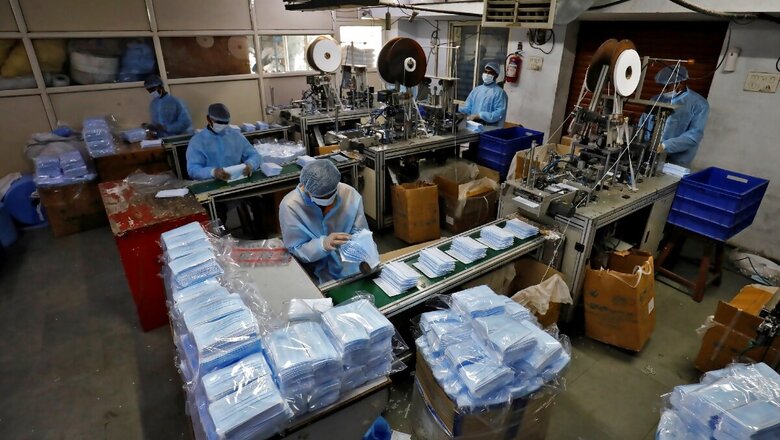
views
The Indian economy contracted by nearly a fourth or 24% in the Covid-19 lockdown months of April, May and June (Q1) this fiscal year. This is the deepest economic contraction on record. But the bad news doesn’t end here.
It is very likely that the GDP numbers could get revised further downward going forward due to challenges in data collection during the lockdown months. Our GDP calculation method uses formal sector activity as a proxy for informal sector activity. The coronavirus pandemic has affected the informal sector more than the formal sector, but this may not immediately reflect in the numbers. The informal sector accounts for roughly half of India’s GDP.
“GDP at constant (2011-12) prices in Q1 of 2020-21 is estimated at Rs 26.90 lakh crore as against Rs 35.35 lakh crore in Q1 of 2019-20, showing a contraction of 23.9 per cent as compared to 5.2 per cent growth in Q1 2019-20,” a statement from the statistics ministry said.
According to government data, the biggest contraction was seen in three crucial pillars of the economy: 1) trade, hotels and transport which contracted by a whopping 47%; 2) construction sector, which shrank to half its size; 3) manufacturing was down by nearly a fourth at -23.3%. Agriculture sector remained the outlier with a growth of 3.4% during the quarter.
So what does a sharp, unprecedented contraction in GDP mean for the aam aadmi? A shrinking economy means job creation is not possible; also, existing jobs and incomes get severely impacted. As incomes get affected, the government and the Reserve Bank of India (RBI) need to step in to boost economic growth and ease the pain of the aam Aadmi. Are these two institutions doing enough?
DK Joshi, chief economist at ratings agency CRISIL, said he was expecting a fresh fiscal stimulus package from the government, equal to a percent of the GDP. He specifically mentioned vulnerable sections of the population and the Micro, Small & Medium Enterprises (MSME) sector to say that direct support should be offered by the government to these segments of the economy.
On its part, the RBI has anyway been doing the heavy lifting through continuous rate cuts and other measures. But now that inflation has been rearing its ugly head again, the central bank refrained from cutting lending rates further in the August monetary policy announcement. Experts believe any fresh rate cuts may not come till the last quarter (January-March 2021) of this fiscal year.
The government had earlier announced several initiatives which were both, sector specific and reforms oriented. There has been a special package for the MSME sector too. But the focus of the government has been more on structural reforms and less on stimulating demand in the economy; most measures announced till now have been on the supply side.
The government continues to be severely constrained fiscally due to fall in revenues (lower taxes for one) and the RBI’s hands are tied due to inflation concerns. So the best case scenario would be a reduction in the spread of the Covid-19 pandemic and a simultaneous increase in economic activity. Economists believe that if and when the rate at which the infection is spreading gets under control, economic activities will automatically increase and thus push up the GDP print.
“Real GDP growth at (-)23.9% in Q1FY21 was much lower than what markets were expecting. The print indicates that the trough in the economy was much lower than expected and the pickup will likely be more elongated. Production side was pulled down by deep contraction in manufacturing, construction, and trade, hotel, transport sectors while the expenditure side was clearly pushed lower by heavy contraction both in consumption and investment,” said Suvodeep Rakshit, Vice President & Senior Economist at Kotak Institutional Equities
“Going forward, given the gradual improvement in activity indicators (remaining well below pre-Covid levels), the growth recovery will be gradual and contracting for all quarters in FY2021. Further, growth recovery will also be hinged to the curb of the Covid spread and removal of even localised lockdowns. The choice for the government will be on whether the consumption or the investment side needs to be pushed,” Rakshit added.
The GDP number for Q1FY21 at -23.9% comes after a growth of 3.1% in the January-March quarter this year and is in sharp contrast to the 5.4% growth recorded in the same quarter of the previous fiscal. Earlier, CRISIL had noted that in the past 69 years, India has seen a recession only thrice — in FY58, FY66 and FY80. Two consecutive quarters of negative GDP growth constitute a recession and economists have already predicted negative growth in the Q2 and Q3 of this fiscal.
CRISIL said that the reason for the three recessionary years earlier was the same — a monsoon shock that hit agriculture, which was then a sizeable part of the economy. But now, growth in agriculture has actually softened the blow. Besides, the pandemic-induced lockdowns have affected most non-agricultural sectors and global disruption has additionally upended whatever opportunities India had on the exports front.
Now, the government is clearly unable to offer a large enough fiscal solution to the current economic crisis and has wisely also stopped referring to India as either the fastest growing economy or one that is close to reaching the $5 trillion-mark.
The RBI is already burdened with more than its fair share of monetary incentives. Now that Finance Minister Nirmala Sitharaman has already described the Covid-19 pandemic as an “Act of God”, perhaps the Indian economy may truly be ‘ram bharose’.




















Comments
0 comment